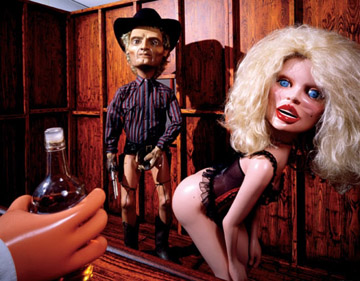Welcome back to BOMB in the Building, where each week we’ll be featuring a vintage BOMB interview relating to a Season 5 artist. This week we present Paul McCarthy’s interview from BOMB Issue 84, Spring 2002, in which he discussed his career as a performer, filmmaker, and family man with his longtime friend and writer Benjamin Weisman. “Paul’s particular Grand Guignol came out of a true personal crisis that dealt with the ghoulish properties of culture, consciousness and family,†Weisman wrote in BOMB. “Paul has managed to remain a radical artist of true perversion, dedicated to fucking with viewer sensibility while at the same time achieving broad mainstream appeal. A rare accomplishment.†Read the full interview here.

Paul McCarthy, "The Saloon" (1995-96), mixed media, 139×191 x 110â€. Installation view showing Dance Hall Girl and Cowboy (Gunfighter). All photos courtesy of the artist and Luhring Augustine Gallery, New York.
Benjamin Weissman: The pulsing id. That’s what I think about when I think about your videos. Partly achieved through minimal dialogue. A generalized wound is articulated, or dug up: anxiety, sexual tension, humiliation, bodily fluids, consciousness. You get a lot of mileage out of wards via a spare, fragmented mumblelogue that’s more like chanting than dialogue, drilling wards into the ground rather than at other characters, and there’s something repetitious about this method, within a single work, then from piece to piece, year to year. Can Paul’s Anxiety Channel accommodate a fuller script, or would that throw your characters into the acting deep end and deflate the luscious fucked-up universe you invent?
Paul McCarthy: In high school I did a drawing of a man’s face looking out of the picture plane straight at the viewer. Behind him in the landscape I drew a square hole in the ground. I have always been interested in digging. I remember finding a rock in a vacant lot when I was five years old. I tried to break the rock. I pounded it with another rock. At one point I stopped pounding it and picked up the rock to carry it home. After a short distance, a head appeared from the rock. I think I was dressed in white. All the houses around me were white. It was a very bright day.
I’ve talked to myself in performances since the ‘60s. But this auto audio babble got louder in the ‘70s. At times I would talk from the moment it started until the moment it ended. A muttering faceted language serving a number of purposes, directed at me and for myself. It’s a multitude, a kind of runabout. A mother, father, brother, sister this and that. In Santa Chocolate Shop there were five performers including myself. In Saloon there were five performers. There was a script, but during the performance the scripts are improvised, repeated, and become language appropriation trying to be mediated into the other.
BW: When you say language serving a number of purposes—what purposes?
PM: A purpose, B purpose, C purpose and so on.
BW: Back in the day a ton of interesting artists were doing performances. Now that energy seems to be directed toward video and film. Artists acting up for the camera. Where has performance gone? Why aren’t people working with the live, high-risk moment? Why do the majority of artists insist on being mediated? Why the distance and safety, why behave on a big installation screen, or a monitor on the floor or a pedestal? I know it’s hard on a performer (physically draining) but that used to be the appeal, the rush, which is why all actors want to perform in plays, the venue of the real. It’s odd to see a whole form almost disappear. There used to be performance magazines and regular venues at museums and galleries for performance. Not too long ago theater and performance were blurring; it was a fertile time.
PM: When I perform for the camera there are others standing on the sidelines in the void. It’s very Hollywood to stand and watch a movie being made. I am planning a performance in a theater in Berlin this year at Christmastime. I don’t know yet whether it will be on the stage or not. I think I would like to use the entire theater as a performance room, the theater as a set. Maybe I will extend the stage out into the audience, reduce the seating. I am interested in blurring our positions. I’ve always been interested in the audience being a prop.
BW: Do you find it strange that people have such strong reactions to fecal matter, blood and mucus? The slightest thing that pops out of us is a total horror. Aren’t these standard human materials? Why the shock of what’s inside us?
PM: Maybe it is a conditioned response: we’re taught to be disgusted by our fluids. Maybe it’s related to a fear of death. Body fluids are base material. Disneyland is so clean; hygiene is the religion of fascism. The body sack, the sack you don’t enter, it’s taboo to enter the sack. Fear of sex and the loss of control; visceral goo, waddle, waddle.
BW: How cool that you’re a grandfather now. How does that affect your understanding of the world?
PM: I spend more time on or near the floor. I seem to be happy down there.
BW: Walt Disney the man, the freak with the harsh, right-wing politics, and Walt Disney the creator of all those remarkable characters and the cheerfully perverse world of Disneyland. Share your Disney thoughts?
PM: Disney has something to do with the future. It’s a virtual space, not unlike the Acropolis. The Disney characters, the environment, the aesthetic are so refined, the relationships so perfect. It’s the invention of a world. A Shangri-La that is directly connected to a political agenda, a type of prison that you are seduced into visiting.
Read the full interview in BOMB Magazine here.



